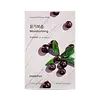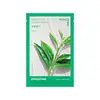What's inside
What's inside
 Key Ingredients
Key Ingredients

 Benefits
Benefits

 Concerns
Concerns

No concerns
 Ingredients Side-by-side
Ingredients Side-by-side

Water
Skin ConditioningMethylpropanediol
SolventButylene Glycol
HumectantCaprylic/Capric Triglyceride
MaskingCetyl Ethylhexanoate
EmollientButyrospermum Parkii Butter
Skin ConditioningMethyl Gluceth-20
HumectantCetearyl Olivate
1,2-Hexanediol
Skin ConditioningGlycereth-26
HumectantSorbitan Olivate
EmulsifyingArginine
MaskingCarbomer
Emulsion StabilisingGlyceryl Caprylate
EmollientSphingomonas Ferment Extract
Skin ConditioningHydrogenated Polyisobutene
EmollientEthylhexylglycerin
Skin ConditioningPaeonia Suffruticosa Root Extract
Skin ProtectingCentella Asiatica Extract
CleansingDisodium EDTA
Allantoin
Skin ConditioningChamomilla Recutita Flower Extract
MaskingEuterpe Oleracea Fruit Extract
Aloe Barbadensis Leaf Juice
Skin ConditioningVanilla Planifolia Fruit Extract
Skin ConditioningRubus Suavissimus Leaf Extract
Skin ConditioningPrunus Persica Fruit Extract
AbrasivePyrus Communis Fruit Extract
Skin ConditioningPrunus Armeniaca Fruit Extract
Skin ConditioningPyrus Malus Fruit Extract
Skin ConditioningHedera Helix Leaf/Stem Extract
AntimicrobialWater, Methylpropanediol, Butylene Glycol, Caprylic/Capric Triglyceride, Cetyl Ethylhexanoate, Butyrospermum Parkii Butter, Methyl Gluceth-20, Cetearyl Olivate, 1,2-Hexanediol, Glycereth-26, Sorbitan Olivate, Arginine, Carbomer, Glyceryl Caprylate, Sphingomonas Ferment Extract, Hydrogenated Polyisobutene, Ethylhexylglycerin, Paeonia Suffruticosa Root Extract, Centella Asiatica Extract, Disodium EDTA, Allantoin, Chamomilla Recutita Flower Extract, Euterpe Oleracea Fruit Extract, Aloe Barbadensis Leaf Juice, Vanilla Planifolia Fruit Extract, Rubus Suavissimus Leaf Extract, Prunus Persica Fruit Extract, Pyrus Communis Fruit Extract, Prunus Armeniaca Fruit Extract, Pyrus Malus Fruit Extract, Hedera Helix Leaf/Stem Extract
Water
Skin ConditioningButylene Glycol
HumectantDipropylene Glycol
HumectantGlycerin
HumectantGlyceryl Polymethacrylate
Ceramide AP
Skin Conditioning1,2-Hexanediol
Skin ConditioningPolyglyceryl-10 Laurate
Skin ConditioningCarbomer
Emulsion StabilisingArginine
MaskingGlyceryl Caprylate
EmollientXanthan Gum
EmulsifyingEthylhexylglycerin
Skin ConditioningCamellia Sinensis Leaf Extract
AntimicrobialPaeonia Suffruticosa Root Extract
Skin ProtectingCentella Asiatica Extract
CleansingDisodium EDTA
Chamomilla Recutita Flower Extract
MaskingRosa Damascena Flower Water
MaskingPyrus Communis Fruit Extract
Skin ConditioningCucumis Melo Seed Extract
Skin ConditioningDiethylhexyl Sodium Sulfosuccinate
CleansingIris Florentina Root Extract
MaskingSodium Hyaluronate
HumectantVetiveria Zizanoides Root Oil
MaskingWater, Butylene Glycol, Dipropylene Glycol, Glycerin, Glyceryl Polymethacrylate, Ceramide AP, 1,2-Hexanediol, Polyglyceryl-10 Laurate, Carbomer, Arginine, Glyceryl Caprylate, Xanthan Gum, Ethylhexylglycerin, Camellia Sinensis Leaf Extract, Paeonia Suffruticosa Root Extract, Centella Asiatica Extract, Disodium EDTA, Chamomilla Recutita Flower Extract, Rosa Damascena Flower Water, Pyrus Communis Fruit Extract, Cucumis Melo Seed Extract, Diethylhexyl Sodium Sulfosuccinate, Iris Florentina Root Extract, Sodium Hyaluronate, Vetiveria Zizanoides Root Oil
 Reviews
Reviews

Ingredients Explained
These ingredients are found in both products.
Ingredients higher up in an ingredient list are typically present in a larger amount.
1,2-Hexanediol is a synthetic liquid and another multi-functional powerhouse.
It is a:
- Humectant, drawing moisture into the skin
- Emollient, helping to soften skin
- Solvent, dispersing and stabilizing formulas
- Preservative booster, enhancing the antimicrobial activity of other preservatives
Arginine is an amino acid that is important for human development. Your body uses is it to produce hair keratin and skin collagen.
As a cosmetic ingredient, Arginine has antioxidant properties and can also help repair damaged skin. This ingredient is derived either synthetically or from animals.
Arginine isn't fungal acne safe when used in the presence of other lipids (fats, fatty acids, oils, esters, etc). Oils and fats occur naturally within the skin, so take caution when using Arginine if you're prone to fungal acne.
Learn more about ArginineButylene Glycol (or BG) is used within cosmetic products for a few different reasons:
Overall, Butylene Glycol is a safe and well-rounded ingredient that works well with other ingredients.
Though this ingredient works well with most skin types, some people with sensitive skin may experience a reaction such as allergic rashes, closed comedones, or itchiness.
Learn more about Butylene GlycolCarbomer is a polymer of acrylic acid. Its main role is to create a gel consistency.
A high amount of carbomer can cause pilling or balling up of products. Don't worry, most products contain 1% or less of carbomer.
Centella Asiatica Extract (Centella) is derived from an herb native to Southeast Asia. It is famous for its anti-inflammatory and soothing properties.
Centella is rich in antioxidants and amino acids, such as Madecassic Acid and Asiaticoside.
Studies show the compounds in centella help with:
The combination of all these properties makes centella effective at soothing, hydrating, and protecting the skin.
Other great components of centella include Vitamin A, vitamin C, several B vitamins, and Asiatic Acid.
Fun fact: Centella has been used as a medicine and in food for many centuries. As a medicine, it is used to treat burns, scratches, and wounds.
Learn more about Centella Asiatica ExtractChamomilla Recutita Flower Extract comes from the Chamomile flower.
Chamomile is rich in antioxidants and has anti-inflammatory properties. Several compounds found in chamomile help with soothing, such as bisbolol.
Antioxidant components in chamomile make it an effective ingredient to help slow the signs of aging. Antioxidants help fight free-radical molecules, or molecules that may damage your skin.
Essential oils from chamomile have been found to improve wound healing due to its antimicrobial properties.
Ancient Greeks and Egyptians used Chamomile to treat skin redness and dryness. Chamomile has also been used to help treat stomach issues.
Learn more about Chamomilla Recutita Flower ExtractDisodium EDTA plays a role in making products more stable by aiding other preservatives.
It is a chelating agent, meaning it neutralizes metal ions that may be found in a product.
Disodium EDTA is a salt of edetic acid and is found to be safe in cosmetic ingredients.
Learn more about Disodium EDTAEthylhexylglycerin (we can't pronounce this either) is commonly used as a preservative and skin softener. It is derived from glyceryl.
You might see Ethylhexylglycerin often paired with other preservatives such as phenoxyethanol. Ethylhexylglycerin has been found to increase the effectiveness of these other preservatives.
Glyceryl Caprylate comes from glycerin and caprylic acid, a fatty acid from coconut. It has emollient and emulsifier properties.
As an emollient, it helps hydrate your skin. Emollients work by creating a barrier on your skin to trap moisture in, helping to keep your skin soft and smooth.
On the other hand, emulsifiers prevent ingredients (such as oil and water) from separating.
Learn more about Glyceryl CaprylatePaeonia Suffruticosa Root Extract comes Peony plant. It has anti-inflammatory and antioxidant properties.
Emerging studies also show peony root may help reduce hyperpigmentation.
Ancient Chinese medicine has used peony root to treat dark spots, but studies are looking into this claim more.
Learn more about Paeonia Suffruticosa Root ExtractWe don't have a description for Pyrus Communis Fruit Extract yet.
Water. It's the most common cosmetic ingredient of all. You'll usually see it at the top of ingredient lists, meaning that it makes up the largest part of the product.
So why is it so popular? Water most often acts as a solvent - this means that it helps dissolve other ingredients into the formulation.
You'll also recognize water as that liquid we all need to stay alive. If you see this, drink a glass of water. Stay hydrated!
Learn more about Water